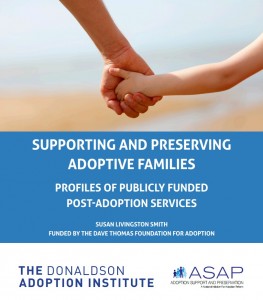 Promoting adoption is not enough for a child; ultimately we want stability for children in their permanency placements. Children may experience adoption disruptions, displacements and dissolutions. Often times these occur because adoptive parents are struggling to find accessible and affordable post-adoption services.
Promoting adoption is not enough for a child; ultimately we want stability for children in their permanency placements. Children may experience adoption disruptions, displacements and dissolutions. Often times these occur because adoptive parents are struggling to find accessible and affordable post-adoption services.
It is estimated that between 10% to 25% of pre-adoption placements are disrupted
The third type of adoption instability is displacement. A displacement is when a child is living in some alternative place that is not the adoptive family home. Examples might be a residential treatment facility, juvenile corrections, a group home, or foster care. Although the child may not be living at home, the parents still have their legal parental rights. Displacement rates have ranged from 2% to 9% in studies [3]
The past few years have seen a growing awareness of the need for post-adoption services and agencies are beginning to respond. However, families often report they still have difficulty finding these services. The Donaldson Adoption Institute is one organization that has been looking at the world of post-adoption services. Their recent review of post-adoption services in the United States found that of the 49 participating states:
- 17 states had developed substantial post-adoption services, including trainings, support groups and specialized services for counseling
- 19 states had moderate services, including trainings and support groups
- 13 states had minimal services, and had no special services other than providing an adoption subsidy for those who had adopted children from state foster care.
States were asked about the ways they provide information and referral services, their education programs, support programs, therapeutic and counseling programs, respite, advocacy on behalf of adoptive parents, and residential treatment services.
To see what your state provides, view the report at the Chronicle of Social Change or the Donaldson Adoption Institute website.
References:
[1] Barth, R.P., Berry, M., Yoshikami, R., Goodfield, R.K. & Carson, M.L. (1996). Predicting adoption disruption. Social Work, 33(3), 227-233. Coakley & Berrick (2008). Research review: In a rush to permanency: Preventing adoption disruption. Child and Family Social Work, 13, 101-112. Festinger, T. (1986). Necessary risk: A study of adoptions and disrupted adoptive placements. Washington, DC: Child Welfare League of America, Inc. [2] General Accounting Office (2002). Foster care: Recent legislation helps states focus on finding permanent homes for children, but long-standing barriers remain. GAO-02-585. Washington, DC: June 28, 2002. Goerge, R. (1999). Adoption, Disruption, and Displacement in the Child Welfare System, 1976-95. Chapin Hall Center for Children, University of Chicago. [3] Festinger, T., & Maza, P. (2009). Displacement or post-adoption placement? A research note. Journal of Public Child Welfare, 3(3), 275-286. Groze, Victor (1996). Successful adoptive families, A longitudinal study of special needs adoption. Westport, CT: Praeger. Howard, J.A. & Smith, S.L. (2003). After adoption: The needs of adopted youth. Washington, DC: Child Welfare League of America.